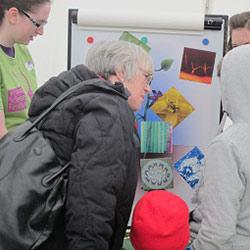
Science on Saturday, 16 March, 2013
Thousands of people braved rain and wind to visit the Sainsbury Lab and other plant research institutions’ activities at the Cambridge Science Festival. A dozen SLCU researchers were on hand to over the course of the day to take members of the public through the Lab’s outreach displays and activities. Smaller children were challenged to design their own plants suited to different environments and weather conditions. Older children and whole families tried their luck at survival as either a wild or crop plant though the Extinct! computer game developed by the Laboratory’s director, Ottoline Leyser.
Microscopy was in focus with a game where participants were asked to match images of plant cells to the correct part of a plant. A poster described various different types of microscopy and why a researcher would choose one sort of imaging approach over another. This also helped explain why two microscopy images of the same part of a plant look wildly different. To bring this all to life, Devin O’Connor provided a dissecting microscope, camera, laptop and various samples from tomato, maize and Arabidopsis plants so people could do some microscopy work of their own.
Feedback was overwhelmingly positive, with one member of the public saying it was fantastic to see an expanding range of activities pitched so that a family of all ages could participate. One child made his way through the SLCU activities twice in a very focussed manner- a future researcher perhaps? The Laboratory will continue to develop and expand its range of activities- over 20% of existing research staff participated in the festival, and with more researchers joining the Laboratory, the pool of ideas, experience and enthusiasm for public engagement will continue to grow.
Science Festival Lecture, 13 March, 2013
120 people braved sleet and hail to hear Dr Siobhan Braybrook <LINK> give a talk on plant architecture, describing how and why plants have the shapes they have, how domestication has influenced this and how plants act as inspiration for new materials and design principles. Demonstrating the multidisciplinary nature of plant science with elements of genetics, geometry, chemistry, physics and anthropology, Siobhan took the audience through the basic building parts of a plant. Drawn models, photograghs and live plants in the auditorium helped the audience understand how plant phenotypes are expressed differently under the influence of both spontaneous and human induced genetic varation.
She then highlighted the influence of plant arcitecture in human design, inspiring everything from solar panel layouts to non stick coatings. She invited the audience to come and discover for themselves the movement of bird of paradise petals which influenced the design of the Thematic Pavillion at Expo 2012. The enthusiastic audience left the Laboratory saying the talk helped them understand some of the mechanics of plant development and how this was evident in their own plants and gardening habits, gave them a new framework and vocabulary when thinking about plants and had (re)kindled their fascination with the wide range of subjects that can fall under 'plant science'.




